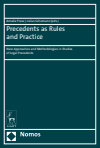Zusammenfassung
Präjudizien haben heute in den unterschiedlichsten Rechtssystemen eine erhebliche Bedeutung für die juristische Entscheidungsfindung. Umso mehr besteht daher das Bedürfnis, deren Entstehungsbedingungen und deren tatsächlichen Einfluss auf die Praxis zu verstehen. Neben dogmatischen Arbeiten wurden in den letzten Jahren vermehrt Studien publiziert, die mit empirischen Methoden sowie sozialwissenschaftlichen Perspektiven der Praxis nationaler wie auch internationaler Gerichte näherkommen wollten. Das gab Anlass verschiedene theoriebezogene wie auch empirische Forschungszugänge, die im Zuge einer Konferenz präsentiert wurden, gemeinsam in einem Buch zu verbinden. So bietet das Buch unter anderem eine Analyse des Einflusses der linguistischen Praxis auf die Entscheidungsbegründungen des EuGH, die Erstellung eines Zitationsnetzwerks sowie ganz generell die Diskussion über den Wert neuer Methoden und Perspektiven in der Arbeit mit und der Forschung zu Präjudizien.
Abstract
What is a legal precedent? How are precedents formed and how do they shape legal outcomes? Over the last decades, a number of studies have appeared that take a socio-legal perspective on the practices of the use of precedents by national and international courts and that have both renewed and extended previous doctrinal discussions on the topic. Based on a conference, this edited volume brings together contributions with different approaches to the study of precedents as both “rules” and “practice”. Rather than studying the binding effect of precedent, the chapters investigate the various conditions of its formation, its forms, and its functions. In so doing, they employ a broad range of methods and add new perspectives to the discussion. Thus, the book not only offers, inter alia, an exploration of the legal actors of precedents and their environment but also gives insights into recent developments in legal methodology for using and studying precedents that is relevant for legal practice and academia alike.

